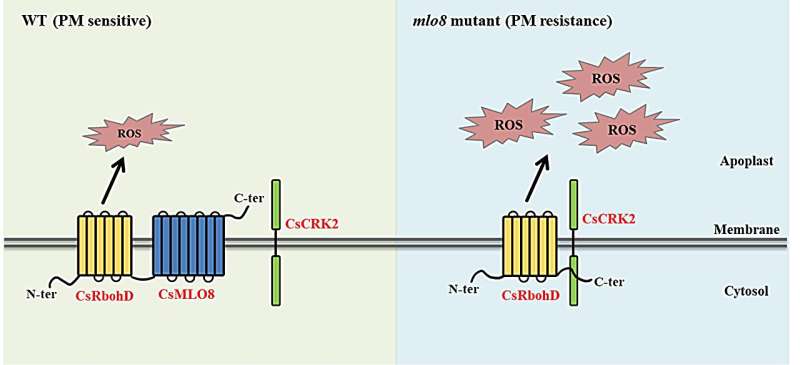This article has been reviewed according to Science X's editorial process and policies. Editors have highlighted the following attributes while ensuring the content's credibility:
fact-checked
peer-reviewed publication
proofread
Researchers find molecular mechanism that regulates powdery mildew resistance in cucumbers

A team from the department of Cucurbitaceae Vegetable Genetics and Breeding, at the Institute of Vegetables and Flowers (IVF, CAAS) has made important progress in the molecular mechanism of powdery mildew (PM) resistance in cucumber.
The paper was published in Horticulture Research, titled "CsMLO8/11 are required for full susceptibility of cucumber stem to powdery mildew and interact with CsCRK2 and CsRbohD."
PM is one of the most destructive diseases that threaten cucumber production globally. Efficient breeding of novel PM-resistant cultivars will require a robust understanding of the molecular mechanisms for cucumber resistance against PM.
Using a genome-wide association study (GWAS), the researchers detected a locus significantly correlated with PM resistance in the cucumber stem—pm-s5.1. A 1,449-bp insertion in the CsMLO8 coding region at the pm-s5.1 locus results in enhanced stem PM resistance.
Knockout mutants of CsMLO8 and CsMLO11 generated by CRISPR/Cas9 both showed improved PM resistance in the stem, hypocotyl and leaves, and the double mutant mlo8mlo11 displayed even stronger resistance.
The researchers found that reactive oxygen species (ROS) accumulation was higher in the stem of these mutants.
Protein interaction assays suggested that CsMLO8 and CsMLO11 could physically interact with CsRbohD and CsCRK2, respectively. Further, they showed that CsMLO8 and CsCRK2 competitively interact with the C-terminus of CsRbohD to affect the CsCRK2-CsRbohD module-mediated ROS production during PM defense.
These findings provide new insights into the understanding of CsMLO proteins during PM defense responses.
More information: Shaoyun Dong et al, CsMLO8/11 are required for full susceptibility of cucumber stem to powdery mildew and interact with CsCRK2 and CsRbohD, Horticulture Research (2023). DOI: 10.1093/hr/uhad295
Journal information: Horticulture Research
Provided by TranSpread




















